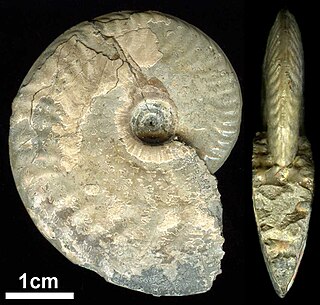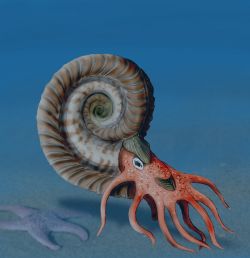
Amaltheus is an oxyconic ammonite with a fairly open umbilicus, serrated keel, and slightly sigmoidal ribs from the Lower Jurassic, many of which are strigate. Amaltheus, named by de Montfort, 1808, is indicative of the upper Pliensbachian stage in Europe, north Africa, Caucasus, Siberia, N. Alaska, Canada, Oregon, and possibly Honduras; and is the type for the Amaltheidae and a member of the Eoderoceratoidea.
Frechiella is an ammonite with a smooth, somewhat globose involute shell that lived during the later part of the Early Jurassic, which has been found in England and Italy. The shell is coiled so that the outer whorls cover most of the inner, leaving the inner whorls only slightly exposed. The outer rim, known as the venter, is broadly arched, with either a low narrow keel bordered by small grooves, or a large median groove.
Haplopleuroceras is a Middle Jurassic ammonite and likely member of the Hildoceratacean family Sonniniidae with which it shares the same sort of ribbing.

Stephanoceratoidea, formerly Stephanocerataceae, is a superfamily of middle- upper Jurassic ammonoid cephalopods within the order Ammonitida containing diverse forms, generally with sharp ribbing and complex suture lines. Aptychi are believed to be mostly granular (Granulaptycus) or concentrically ribbed on the surface (Praestriaptychus)

Hildoceratoidea, formerly Hildoceratacaea, is a superfamily of compressed or planulate ammonites, some tending to develop acute outer rims; generally with arcuate or sigmoidal ribs. Aptichus were found in place are double-valved.

Eoderoceratoidea is a superfamily of true ammonites from the Lower Jurassic, comprising seven phylogenetically related families, characterized in general by having ribbed evolute shells that commonly bear spines or tubercles. Adult shell size ranges from 2 or 3 cm to giants reaching 50 cm in such genera as Apoderoceras, Epideroceras, and Liparoceras.

Eoderoceratidae is the ancestral and most primitive family of the Eoderoceratoidea; lower Jurassic ammonite cephalopods, characterized by evolute, commonly serpenticonic, shells that had long body chambers and would have had no stable floating position; and thus resemble contemporary Psiloceratoidea. Spines, or tubercles, are typically found in two rows on the inner and outer parts of the whorl sides, joined by radial ribs. These are often more developed on the inner and middle whorls, becoming less so or absent on the outer. Sutures are highly complex.
Coeloceratidae is a family of ammonites belonging to the Eoderoceratoidea that lived during the Early Jurassic. Shells are evolute, tending to be broadly discoidal with depressed whorls bearing primary and secondary ribs that branch from outer lateral tubercles. Most of the included species have coronate inner whorls and outer tubercles only. In general, Coeloceratids resemble the Middle Jurassic Stephanoceras. Once regarded as the subfamily Coeloceratinae in the Eoderoceratidae, these ammonites are now given familial rank.

Perisphinctoidea, formerly Perisphinctaceae, is a superfamily of Middle Jurassic (Bajocian) to Lower Cretaceous (Barremian) ammonites, commonly with evolute shells with strong ribbing that typically divides about mid flank before crossing the venter.
Eoderoceras is an evolute, round whorled ammonite from the Lower Jurassic with an outer row of distinct spines, and in some, an inner row of tubercles, on either side; ribs only on the inner whorls.

Oppeliidae are compressed to oxyconic, sculptured Haploceratoidea, either unkeeled, unicarinate, bicarinate, or tricarinate; with sutures in great variety, but ribbing usually more or less falcoid or falcate. The Oppeliidae is the principal family of the Haploceratoidea, with the longest duration, extending from the Middle Jurassic (Bajocian) to the Upper Cretaceous (Cenomanian) Their derivation is from the Hildoceratoidea.

Perisphinctidae is a family of Middle and Upper Jurassic discoidal ammonites in the order Ammonitida. They have a shell morphology that is mostly evolute, typically with biplicate, simple, or triplicate ribbing. Large forms have simple apertures and smooth body chambers while small forms have lappets and ribbed body chambers.
Hammatoceratoidea, formerly Hammatocerataceae was a superfamily of middle Jurassic ammonites erected by Schindewolf in 1964 that combined the families Graphoceratidae, Hammatoceratidae, and Sonniniidae. The three families were previously included in the Hildoceratoidea, however subsequent classifications have moved the families back into Hildoceratoidea.

The family Dactylioceratidae comprises Early Jurassic ammonite genera with ribbed and commonly tuberculate shells that resembled later Middle Jurassic stephanoceratids and Upper Jurassic perisphinctids. Shells may be either evolute or involute.

Harpoceratinae is an extinct subfamily of cephalopods belonging to the family Hildoceratidae. Ammonites of this subfamily had involute and compressed shells with strong keels. Keel might be rarely missing, but this is considered to be an abnormality. This has been observed both in Cleviceras and Harpoceras and called as genus Monestieria, which is now known to be invalid. Another example is Pseudolioceras, whose unkeeled specimen was used as type for description of invalid genus Praehaploceras. Oxyconic forms of this subfamily does not have any keel. Ribs were single, but in some genera also bifurcating with shapes from sigmoidal to falcate. Sometimes, shell can have only striate ribs or is smooth. Tubercules are rare. Dimorphism is known in some genera and it is observable mostly in size. Macrochons can be 4, to 6 times larger than microconchs. As an example, macroconchs of Pseudolioceras are more than 150mm in diameter, while adult microconchs are only 35-50mm. There are big size differences even within dimorphs. Specimens ca be 2, or sometimes even 3 times bigger than other specimens of same dimorph.
Streblitinae is a subfamily of Upper Jurassic and Lower Cretaceous ammonites within the family Oppeliidae characterized by compressed, involute shells; typically oxycones with complex sutures. Includes Streblites, Pseudoppelia, and Substreblites. Derivation is from the Taramelliceratinae. May have given rise to the Aconiceratinade.
Erycitidae is a family of Lower and Middle Jurassic ammonites included in the Hildoceratoidea. The hammatoceratid subfamily Erycitinae is equivalent. Genera include Erycites (type) and Abbasites.

Hammatoceratidae is a family of lower and middle Jurassic ammonites included in the superfamily Hildoceratoidea.

Hammatoceras is a genus of ammonites belonging to the family Hammatoceratidae which lived during the Toarcian stage of the Early/Lower Jurassic between about 184 and 175 million year ago.

Hildoceratinae is an extinct subfamily of cephalopods belonging to the family Hildoceratidae. Ammonites of this subfamily had shells with elliptical or quadrate whorl section with keel or tricarinate, bisulcate venter. Ribs were variable, from falcate to strongly angled and from fine to strong. They can be interrupted by spiral groove in midlateral part of the shell. While some species can be smooth, strongly ribbed ones can have tubercules. Microconchs have short lapplets that is in its shape similar to the shape of growth lines in spiral midlateral groove.












